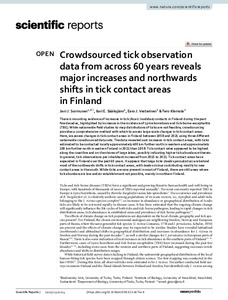Crowdsourced tick observation data from across 60 years reveals major increases and northwards shifts in tick contact areas in Finland
Sormunen Jani J.; Sääksjärvi Ilari E.; Vesterinen Eero J.; Klemola Tero
https://urn.fi/URN:NBN:fi-fe2025082791419
Tiivistelmä
There is mounting evidence of increases in tick (Acari: Ixodidae) contacts in Finland during the past few decades, highlighted by increases in the incidence of Lyme borreliosis and tick-borne encephalitis (TBE). While nationwide field studies to map distributions of ticks are not feasible, crowdsourcing provides a comprehensive method with which to assess large-scale changes in tick contact areas. Here, we assess changes in tick contact areas in Finland between 1958 and 2021 using three different nationwide crowdsourced data sets. The data revealed vast increases in tick contact areas, with ticks estimated to be contacted locally approximately 400 km further north in western and approximately 100 km further north in eastern Finland in 2021 than 1958. Tick contact rates appeared to be highest along the coastline and on the shores of large lakes, possibly indicating higher tick abundance therein. In general, tick observations per inhabitant increased from 2015 to 2021. Tick contact areas have expanded in Finland over the past 60 years. It appears that taiga ticks (Ixodes persulcatus) are behind most of the northwards shifts in tick contact areas, with Ixodes ricinus contributing mostly to new contact areas in the south. While ticks are now present in most of Finland, there are still areas where tick abundance is low and/or establishment not possible, mainly in northern Finland.
Kokoelmat
- Rinnakkaistallenteet [27094]
